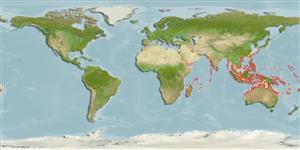Common names from other countries
Environment: milieu / climate zone / depth range / distribution range
Ecología
Asociado a arrecife; rango de profundidad 3 - 35 m (Ref. 8294). Tropical; 35°N - 34°S, 27°E - 175°W (Ref. 846)
Indo-Pacific.
Length at first maturity / Tamaño / Peso / Age
Maturity: Lm ? range ? - ? cm Max length : 25.0 cm BRW macho / no sexado; (Ref. 269)
This hispidose branching coral forms colonies up to several meters in diameter and is common from shallow to intermediate depths throughout its range. It has stout branches up to 25 cm thick that appear "knobby" on the surface due to secondary branchlets of even height (Ref. 269).
Common at shallow to intermediate depths throughout its range (Ref. 269). On subtidal reef tops, walls and slopes (Ref. 98471).
Life cycle and mating behavior
Madurez | Reproducción | Puesta | Huevos | Fecundidad | Larva
Hermaphroditic (Ref. 113712). Mature gametes are shed into the coelenteron and spawned through the mouth. Life cycle: The zygote develops into a planktonic planula larva. Metamorphosis begins with early morphogenesis of tentacles, septa and pharynx before larval settlement on the aboral end (Ref. 833).
Hodgson, G. 1998. (Ref. 269)
IUCN Red List Status (Ref. 130435)
CITES status (Ref. 108899)
Not Evaluated
Human uses
| FishSource |
Herramientas
Fuentes de Internet
Estimates based on models
Preferred temperature
(Ref.
115969): 24.6 - 28.8, mean 27.6 (based on 470 cells).
Vulnerability
Low vulnerability (15 of 100).
Price category
Unknown.
